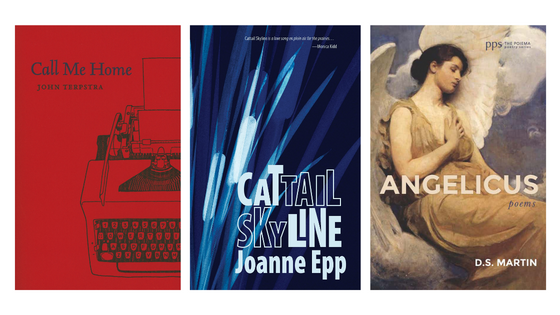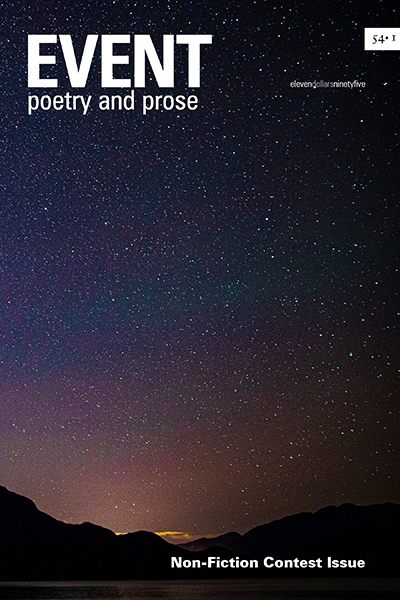John Van Rhys Reviews New Poetry for EVENT 51/2
John Van Rhys Reviews:
Joanne Epp, Cattail Skyline, Turnstone Press, 2021
D.S. Martin, Angelicus: Poems, Cascade Books, 2021
John Terpstra, Call Me Home, Gaspereau Press, 2021
Poetry often aims to show the extraordinary within the ordinary. Other times, it seeks to make ordinary—understandable and down to earth—what is extraordinary. In Joanne Epp’s Cattail Skyline and John Tersptra’s Call Me Home, we have poems of the first variety; in D.S. Martin’s Angelicus, we find poems of the second type. What all three poets do is invite us to slow down from the manic pace of contemporary life, to see, feel and consider anew what is lasting and life-sustaining.
A poet raised in Saskatchewan, now living in Manitoba, Joanne Epp fills Cattail Skyline with poems that evoke the prairie landscape, while also journeying as far away as Cambodia. Sections with titles such as ‘How far can we follow’ and ‘I used to know the place’ deftly suggest Epp’s attention to motion, memory and meaning. One section portrays a Winnipeg stream in a poem sequence running from April of one year through March of the next, tracing the boundary between city and wilderness. Stitched between the sections are a series of prose poems, titled and numbered as ‘Cemetery road.’ Just as Epp travelled this road in youth and has continued to do so in adulthood, readers revisit this site suggestive of life’s journey, this reminder of the poet’s and our own mortality.
Epp’s poems are born of a patient waiting, an attentiveness to the world that rewards such patience. In ‘Lanigan Creek,’ for example, the poet says, ‘I sidestep down the bank, crouch low./Blackbirds whistle. I wait.’ The result of this waiting? ‘Below the cattail skyline, time/becomes elastic. The silence hums.’ What stands out is the specificity of Epp’s attention, and the reactions that result. The ‘Ormand’s Creek’ sequence begins with April, ‘Open arms,’ where poet and readers are called to ‘Welcome snow’s final retreat/that lays everything bare: blue/Pepsi cup, green plastic bag/stark against dead grass,/a call to repentance.’ The closing poem for March, ‘Alert,’ contains a similar call: ‘You, too, watch for signs/of what’s coming. You listen hard/for the sound of the meltwater, wait to be told/how to love the world.’ Epp’s poetry is invitational in both voice and form, with gentle imperative verbs such as ‘wait’ and ‘welcome’ structuring a number of poems, sometimes through anaphora.
Epp’s vision is vividly close-up—focusing on wildflowers and shrubs, fruit and all manner of creatures—but also panoramic. In ‘Bearings,’ the poet uses maps to explore the visible and invisible lines, the land and history, the ethnic groups and the ethnic divides of the landscape she is familiar with in Saskatchewan. Through Epp’s attention to the history of these spaces, readers visit and revisit, remember and resee—and sometimes even get lost.
What shines through in the end are seasonal rhythms that coincide with spiritual rhythms that themselves point to a kind of fruitfulness, even in the shadow of the cemetery. It’s the magic and mystery of a sun-drenched country church: ‘It’s here/in this small clearing—that glory, declared/in morning rays through arched windows,/shining the varnished pews;/in brightness flashing out from everything.’
In a different geography with a different voice, John Terpstra in Call Me Home directs readers’ attention to similar mysteries, to the extraordinary ordinary. Well known as a poet of Hamilton, Ontario, Terpstra centres this volume, as the title suggests, on his home—in fact on the front porch, from which he observes his neighbourhood and city. But he doesn’t stay there, travelling wide until he is again ‘called home.’ All this he does with an engaging colloquial style, varied in tone, and in a serio-comical voice shot through with self-deprecation. It’s what we hear in ‘Muse,’ where the poet seeks inspiration from a fly.
This approach is fully on display in ‘Dante Park,’ where he confesses his envy of the productive lives his brother and sister-in-law seem to be leading, especially when compared to his porch musings. In answer to a neighbour’s question about the ‘paperwork’ the poet is doing, he considers saying in jest, ‘I’m rewriting the Divine Comedy,/with myself in the starring role,’ but refrains. Instead, he meditates on words his mother, affected by dementia, once said about her inability to enjoy a family wedding. The poet reflects, ‘her words that day/have lingered on, liturgically, long past/her last breath. They hang in the air/above my head, in a cartoon bubble/that’s trapped against the porch ceiling.’ In the final lines, he echoes his mother’s words, with a twist—at least temporarily—to the positive: ‘I should be enjoying this, and/for the moment, I am.’
This apparently loose style, with its liberally enjambed lines that spin out images and thoughts, is, in its own way, as carefully crafted and invitational as Epp’s. It’s a style that Terpstra uses to great effect in several narrative poems within the volume, which attest to the rich territory and range of his musings throughout the volume. He reflects on the hidden life of the city: the water pipes below the surface, the squirrels inhabiting the trees, and the life of a neighbour journeying down the sidewalk in a motorized mobility scooter. He treats the theme of age in conversation with youth and explores lifelong relationships, with aging parents, siblings and neighbours. Moreover, several of the poems point inward to the territory of self-knowledge, whether it be a humorous recognition of his own animal hungers in ‘Belly Wolf,’ or a more serious sense of a danger narrowly averted, a ‘yen for oblivion/that had burrowed into my bones,/the desire to spend all my days/beneath a tree, preferably/beside a creek, watching the water flow.’
Like Epp, Terpstra looks for signs of redemption in this ordinary world. Poems such as ‘Dog Day Late Afternoon’ certainly explore the brokenness and disorientation of contemporary life. But there is nevertheless a search that may bring fulfillment: ‘I stand here, a non-native son,/though born on this soil,/and walk my walk,/banging through the woods,/cowbell around my neck,/head in a cloud of bugs,/birds nesting in my beard,/searching for a place that will call me home.’ That being at home in the world is found in the volume’s final poem, ‘Heaven,’ where the poet, swimming and splashing with a child, speaking to the child’s curiosity about death, says, ‘heaven is the water that comes to my waist,/and a cloud-touching, glad-dunking/child of the earth,/who can’t get enough of this/reality.’
This is the extraordinary that both Terpstra and Epp find in the ordinary.
By contrast, in Angelicus D.S. Martin uses the extraordinary to illuminate the ordinary. In a sense, while Epp and Terpstra approach the light obliquely, slant-wise to use Emily Dickinson’s term, Martin shines a light on human affairs from the perspective of another dimension.
His starting point is the mystery and ambiguity that surround angels in the Bible, angels as messengers. In his volume, he not only draws fully on the biblical references to angels—on stories of encounters experienced by Abraham and Mary, prophetic references in the Old Testament and the Book of Revelation in the New—but he also draws upon rich attention to angels through the centuries by theologians, Renaissance artists, writers and even pop musicians. In this, Martin is both playful and serious in his engagements. For example, he has poems prompted by Caravaggio’s Saint Matthew and the Angel (one of several ekphrastic poems), an Elizabeth Barrett Browning sonnet, the ending of Hamlet, putti in paintings and William Blake’s visionary poetry.
Martin’s method is to quite literally make angels the messengers in these poems. That is, each poem is crafted as an angel’s voice speaking directly to humans, frequently addressed as ‘children of clay,’ or commenting on human affairs. By doing so, the poet is able to ‘make strange’ for readers their own humanity, to bring to bear an alternative perspective on it. And Martin crafts these voices with a prosody that’s fittingly playful, with a soundscape filled with alliteration, assonance and rhyme. A fine example is ‘An Angel Laughs about Laundry,’ inspired by Richard Wilbur’s ‘Love Calls Us to the Things of This World,’ particularly the line, ‘Outside the open window/The morning air is all awash with angels.’ Here are Martin’s opening lines: ‘If ever we wanted to hide in plain sight/it would be out in the pure light/of washday where the homebound hope/the soap & sun will wash away each stain.’ These techniques (voice and prosody) enable Martin to ponder and comment on human culture, creations, behaviours and ambitions, as well as to offer contemporary understandings of biblical stories and how they still speak to life today.
As with Epp and Terpstra, Martin’s poems invite us to a deeper, richer understanding and appreciation of life. We hear it in ‘What an Angel Admires,’ calling us to see our world with fresh eyes: ‘Oh if you saw how the eyeblue tinge/of your home floats in space you’d/feel its lyrical pull.’ This note is there again in the line ‘So come dance with us child,’ from ‘In the Early Morning.’ It is sounded more fully in ‘Learning to Fly,’ Martin’s meditation on human aspirations, focusing particularly on Leonardo Da Vinci’s spirit of discovery. In the final lines, says the angel, ‘Leonardo tried many things knowing how to look/& guess & learn from every fall/perhaps knowing how God loves a puzzle/the biggest an intricate universe made oh so discoverable.’ And we hear this invitation in the volume’s final poem, ‘Surreal Orchid,’ where Martin offers the orchid as an extended analogy for faith, where the angel says, ‘Let it encircle your heart let it fill your brain/with its delicate fulgour/let it be the fulfillment to the prayer/you most frequently ask.’
The invitational quality of the poetry in all three volumes thus ‘calls us home,’ each in their distinctive way. In his afterword, Terpstra offers this thought about poetry: ‘The right words at the right time in the right place. That’s one definition of the gift, given or received.’ This is the rich gift offered to readers in these volumes.
—John Van Rhys














